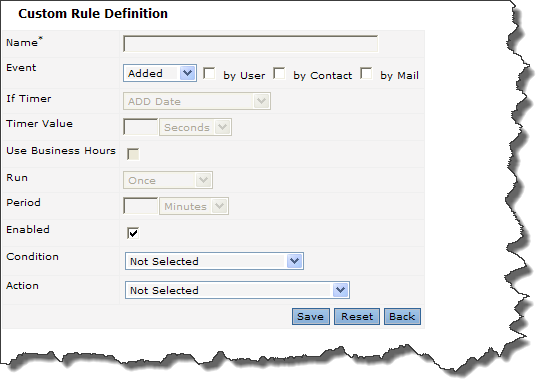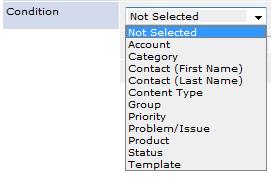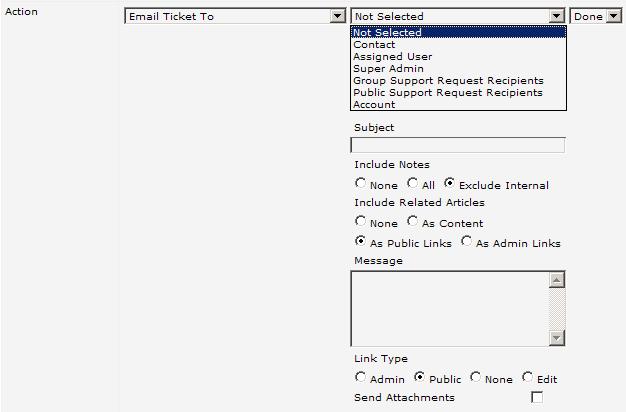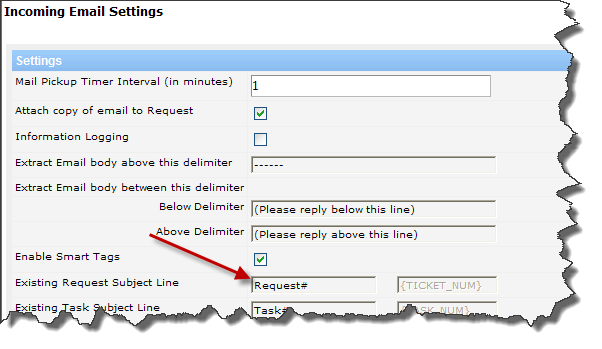Using Custom Rules for Novo Requests
Purpose: The Custom Rules feature allows Request administrators turn Request Management into a fully-automated process by having the Request trigger actions based on an event and/or a condition.
Prerequisites: Novo initial software settings, Request configured, List of events to be automated.
Steps:
-
Click Admin->Setup->Requests->Custom Rules.
- Click the Add New Custom Rule button. The Custom Rule Definition window appears as shown below.

- Enter a Name for the rule.
- Choose an Event type from the drop-down list. The options are:
- If needed, specify a Timer Value by entering a whole number in the adjacent field, then selecting one of the IF Timer options shown above. When the runtimerudr.bat runs (discussed below), the application will calculate the difference between the selected IF Timer option and the value in the Timer Value using the selected increment; (seconds, minutes, hours or days) and run the rule if the server DateTime has met or surpassed the calculated value.

- Use Business Hours - Select this if you want the Application to calculate timer based rules using the settings you provide on the Business Hours definition page. This control will only be enabled when Timer is selected for the Event type.
- Run - Determine whether a Timer rule should run only Once or Repeatedly. This control, and the Period control below, will only be enabled when Timer is selected for the Event type.
- Period - If you selected Repeatedly above, set the time interval the rule should repeat in Minutes, Hours or Days.
- Enable - Uncheck this to disable the rule.
- Start Date/Time - works in conjunction with the End Date/Time to allow a rule to run for a specific time period.
- End Date/Time - works in conjunction with the Start Date/Time to allow a rule to run for a specific time period.
- Choose a Condition. If no Condition is selected, depending on how it is configured, the rule will run when any Add, Modify or Timer Events occur. The following attributes are available:
- Account
- Account Name
- Assigned User
- Assigned User (First Name)
- Assigned User (Last Name)
- Category
- Contact (First Name)
- Contact (Last Name)
- Content Type
- Description
- Due Date
- Group
- Internal
- Initial Response Date
- Priority
- Product
- Received By Email Account
- Request Title
- Status
- Template

- Once a condition is selected, the screen is updated and two additional drop-downs and (depending on the condition) a selection box or text field will be displayed. These are used to build the condition.

-
Build the condition by selecting the values you want from the available options.
In the right-hand drop-down list, select one of the following options:
- Done, if your condition is completed,
- And, if you would like to extend your condition,
- Or, if you would like to add an alternative condition.
- Delete, allows you to delete the condition
- Select an Action to be triggered by the rule. Available Actions are:
- Email request To
- If you select "Email request to...", you can simply type an email address into the "To" field or you can use any the following variables:
| Option | Variable | Action |
| Contact | {CUSTOMER_EMAIL} | Email the contact |
| Assigned User | {USER_EMAIL} | Email the admin user who is assigned to the request |
| Super Admin | {ADMIN_EMAIL} | Email all Super Admins |
| Group Support Request Recipients | {GROUP_EMAIL} | Email all admin users designated as Group Support Request Recipients |
| Public Support Request Recipients | {PUBLIC_EMAIL} | Email all addresses in Request Setting -> Public Support Request Recipients |
| Account | {ACCOUNT_EMAIL} | Email all addresses associated with an Account |
- You can click the Drop Down list to show and select the variables

- When a variable is selected, the "To" field below the list is auto-populated

- You can also select several variables within the same action. The example below shows that the Contact and the Assigned User are to be notified.

- More Email options:
You can choose to set an alternate From email address if you want the recipient's reply to go to a different address such as the ATS monitored account.
You can also choose whether to include any Notes, Related Articles and/or Attachments and determine the Link type. - Request ID in the Subject Line - To place the Request ID into the subject line, use the {TICKET_NUM} variable.
- The string below, if the rule is applied to request ID 1204, would cause the email subject line to appear as: Request ID in Subject 1204

- If you are using a Custom Rule in conjunction with the Novo Mail Service, and you want recipients to reply to the Novo Mail Service monitored account to capture email threads in requests, you will want to format the request ID variable to match the Existing Request Subject Line setting on the Incoming Email Settings page; (see below).

So the subject should include [Request#{TICKET_NUM}]. The string below, if the rule is applied to request ID 1204, would cause the email subject line to appear as: My Subject [Request#1204]

When the Novo Mail Service processes an incoming email with a correctly formatted request ID in the Subject, assuming the reply text is between or above the delimiters, the service will create a note for the referenced request.
- The following Actions are available:
- Relate Article ID - entered value
- Update Due Date To - any date based on specific criteria
- Email Request To - specified individuals or email addresses
- Assign Request To - any admin user
- Change Status To - any or the pre-defined or user-defined Statuses
- Update Category To - any Category that is visible in the Request
- Update Product To - any Product
- Update Priority To - any Priority
- Update Contact To - any Contact - A textbox will appear with a Select button. Press the select button to show the Accounts/Contacts management page. There, you can search for and select a contact by clicking the select icon
 by their name.
by their name. - Update Group To - any Group
- Update Content Type To - any Content Type that is visible in the Request
- Add WorkFlow - that is visible in the Request
- Log Event As - Informational, Warning or Failure - These are logged to the Request Log on the main Custom Rules page.
- Update Template To - any Request Template
- Delete Request - This will permanently delete the request. Use with caution.
- Update Iniital Response Date/Time - updates the Initial Response Date/Time
- Update Approval Status To - a specific date/time
- Update Change Status To - any status
- Change Request Title To - the entered value
- Append Request Title To - the entered value
- Append Resolution with - the entered value
- Add Note - with the entered value
- Update User Defined Field - any User Defined Field
- In the right-hand drop-down list, select one of the following options:
- Done, if your Action is completed,
- And, if you would like to extend your Action,
- Or, if you would like to add an alternative Action,
- Delete, allows you to delete the Action.
Enabling Timer Rules
To enable the Timer option for Custom Rules, you first need to use the Task Manager in Windows to schedule a task to run the runtimerudr.bat file periodically (for example, 1–5 minutes) so it checks whether the Timer Condition for triggering an Action has been met (for instructions review the Enable the Timer Option for Custom Rules subarticle).
Sub Articles
 Using Request Parameters with Custom Rules
Using Request Parameters with Custom Rules
 Request Manager Timer Rules
Request Manager Timer Rules
 How to Log Custom Rules
How to Log Custom Rules
 Creating a rule that fires on the "Close" event
Creating a rule that fires on the "Close" event
 Creating a Rule based on Incoming Email Addresses
Creating a Rule based on Incoming Email Addresses
Related Articles
 Assigning WorkFlows to Requests
Assigning WorkFlows to Requests
 Assigning WorkFlows via Custom Rules
Assigning WorkFlows via Custom Rules